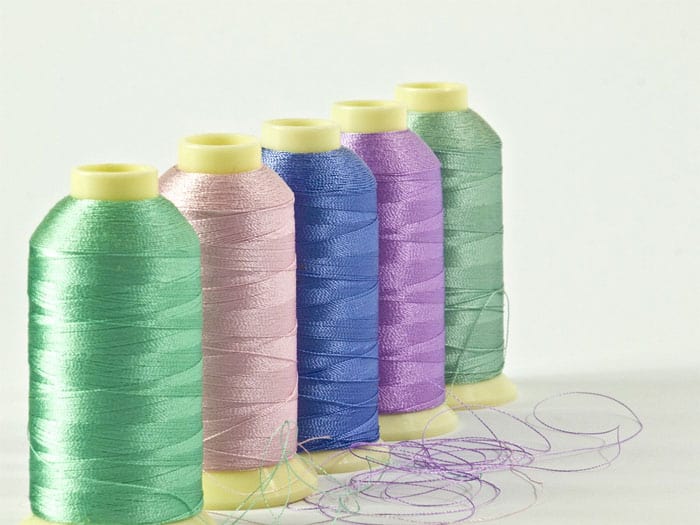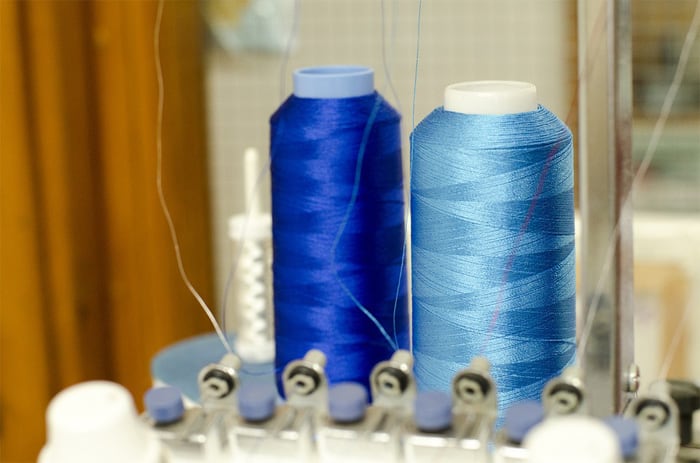The art of embroidery is ancient, and it’s well known in almost all the cultures of our world. It’s hard to find a place where people dislike embroidered clothing and accessories, which is why this art is famous.
Many people aspire to learn embroidery every year, but they stumble along the way as it’s a tricky art to master. One of the main things people stumble upon is the thread.
Threads are one of the main components of embroidery, and it’s essential to choose these carefully if you want your embroidery to be perfect.
What are the different types of embroidery threads? That’s exactly what we’re going to discuss now.
Different Types of Embroidery Threads

Here, you’ll learn about the various kinds of embroidery threads.
Metallic
The metallic threads come in all colors, but mostly we find them in gold, silver, and copper. The specialty of these threads is that they reflect light, which makes them pop out of the dress. Due to this effect, metallic threads are used as highlighters on dresses.
However, working with these can be a bit challenging, as they tend to tangle if they get too long. This is why it’s recommended to shorten them before you start using them. Some also use thread conditioners to dampen these, and that works well too.
Embroidery Cotton
When you set out, you’ll find standard embroidery cotton threads that are made especially for this purpose. These threads come in all sorts of colors, and you can identify specific colors with color code labels on them.
The best part about these cotton threads is that their thickness is customizable. These threads come in six strands, and you can always adjust these strands to suit your needs.
Due to their customizability, these cotton threads are suitable for all sorts of fabric arts, including delicate forms of art like needle painting.
Overall, these are some of the best types of threads that you can get for embroidery.
Wool
Wool is another amazing type of thread that you can use for embroidery. Woolen threads come in all sorts of thicknesses, and that thickness is determined by ‘yarn weight’. There is a total of eight thicknesses that you can get woolen threads in, and that ranges from 0 to 7.
There are different types of special woolen threads. For example, Persian yarn is a popular 3-ply woolen thread that’s adjustable, just like the embroidery cotton threads.
Another popular type of woolen thread is Tapestry yarn, which is non-separable. Then again, Crewel yarn is a 1-ply thread that’s great for Crewel embroidery.
Perle Cotton
Perle cotton threads weren’t that popular back in the days, but now their popularity is only growing, and it’s predicted that they’ll become the most widely used threads in the years to come.
These threads can be found in many colors as well. However, they lack a unique feature that makes the special embroidery cotton better. You won’t be able to adjust the thickness of these threads. Even though they come in different thicknesses, the adjustability offers more flexibility.
Silk

Silk is another great used thread in embroidery. These are especially good for fine embroidery, and you can create delicate designs with these threads. However, these aren’t as used because the silk threads have some drawbacks.
One of the worst things about these threads is that their colors fade and wash away very fast. This is a major con, which is one reason why silk isn’t used much these days.
Satin Threads
The satin and rayon threads are shiny like the metallic threads, and these can be tough to work with as well. The major difference between satin threads and metallic threads is that satin threads come in flosses where the plies can be separated, and this gives an added edge over the metallic threads.
Just like metallic threads, satin threads are hard to work with as well. It can be easier to use the threads by applying thread conditioners over them.
Novelty Threads
Novelty threads can be made of different materials. You’ll get them in wool, cotton, and they might come with laces as well. The specialty of these threads is that they come with fancy textures that allow the craftsperson to add different textures to the embroidery.
Variegated
The variegated threads are essentially locks of threads that offer different shades of the same color in one lock. They come in Perle cotton, cotton, silk, and even wool. These are amazing as they allow us to create different textures and designs easily.
Conclusion
It’s important to know what the different types of embroidery threads are, as it will allow you to choose the right thread for your embroidery. We highly recommend you keep the mentioned facts in mind when you’re working with embroidery.

